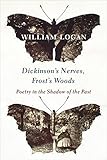Dickinson's Nerves, Frost's Woods : Poetry in the Shadow of the Past / William Logan.
Material type: TextPublisher: New York, NY : Columbia University Press, [2018]Copyright date: ©2018Description: 1 online resource : 21 imagesContent type:
TextPublisher: New York, NY : Columbia University Press, [2018]Copyright date: ©2018Description: 1 online resource : 21 imagesContent type: - 9780231186148
- 9780231546515
- 821.009 23/eng/20240417
- online - DeGruyter
| Item type | Current library | Call number | URL | Status | Notes | Barcode | |
|---|---|---|---|---|---|---|---|
 eBook
eBook
|
Biblioteca "Angelicum" Pont. Univ. S.Tommaso d'Aquino Nuvola online | online - DeGruyter (Browse shelf(Opens below)) | Online access | Not for loan (Accesso limitato) | Accesso per gli utenti autorizzati / Access for authorized users | (dgr)9780231546515 |
Browsing Biblioteca "Angelicum" Pont. Univ. S.Tommaso d'Aquino shelves, Shelving location: Nuvola online Close shelf browser (Hides shelf browser)

|

|

|

|

|

|

|
||
| online - DeGruyter The Varieties of Temporal Experience : Travels in Philosophical, Historical, and Ethnographic Time / | online - DeGruyter Ulysses by Numbers / | online - DeGruyter The Tale of Cho Ung : A Classic of Vengeance, Loyalty, and Romance. | online - DeGruyter Dickinson's Nerves, Frost's Woods : Poetry in the Shadow of the Past / | online - DeGruyter Jordan and the Arab Uprisings : Regime Survival and Politics Beyond the State / | online - DeGruyter Media U : How the Need to Win Audiences Has Shaped Higher Education / | online - DeGruyter Worlds of Journalism : Journalistic Cultures Around the Globe / |
Frontmatter -- Contents -- List of Illustrations -- Acknowledgments -- Notes Toward an Introduction -- 1. Shelley’s Wrinkled Lip, Smith’s Gigantic Leg -- 2. Frost’s Horse, Wilbur’s Ride -- 3. Lowell’s Skunk, Heaney’s Skunk -- 4. Longfellow’s Hiawatha, Carroll’s Hiawatha: The Name and Nature of Parody -- 5. Keats’s Chapman’s Homer, Justice’s Henry James -- 6. Shakespeare’s Rotten Weeds, Shakespeare’s Deep Trenches -- 7. Pound’s Métro, Williams’s Wheelbarrow -- 8. Dickinson’s Nerves, Frost’s Woods -- Permissions -- Notes -- Index
restricted access online access with authorization star
http://purl.org/coar/access_right/c_16ec
In Dickinson’s Nerves, Frost’s Woods, William Logan, the noted and often controversial critic of contemporary poetry, returns to some of the greatest poems in English literature. He reveals what we may not have seen before and what his critical eye can do with what he loves. In essays that pair different poems—“Ozymandias,” “On First Looking Into Chapman’s Homer,” “In a Station of the Metro,” “The Red Wheelbarrow,” “After great pain, a formal feeling comes,” and “Stopping by Woods on a Snowy Evening,” among others—Logan reconciles history and poetry to provide new ways of reading poets ranging from Shakespeare and Shelley to Lowell and Heaney.In these striking essays, Logan presents the poetry of the past through the lens of the past, attempting to bring poems back to the world in which they were made. Logan’s criticism is informed by the material culture of that world, whether postal deliveries in Regency London, the Métro lighting in 1911 Paris, or the wheelbarrows used in 1923. Deeper knowledge of the poet’s daily existence lets us read old poems afresh, providing a new way of understanding poems now encrusted with commentary. Logan shows that criticism cannot just root blindly among the words of the poem but must live partly in a lost world, in the shadow of the poet’s life and the shadow of the age.
Mode of access: Internet via World Wide Web.
In English.
Description based on online resource; title from PDF title page (publisher's Web site, viewed 25. Jun 2024)


